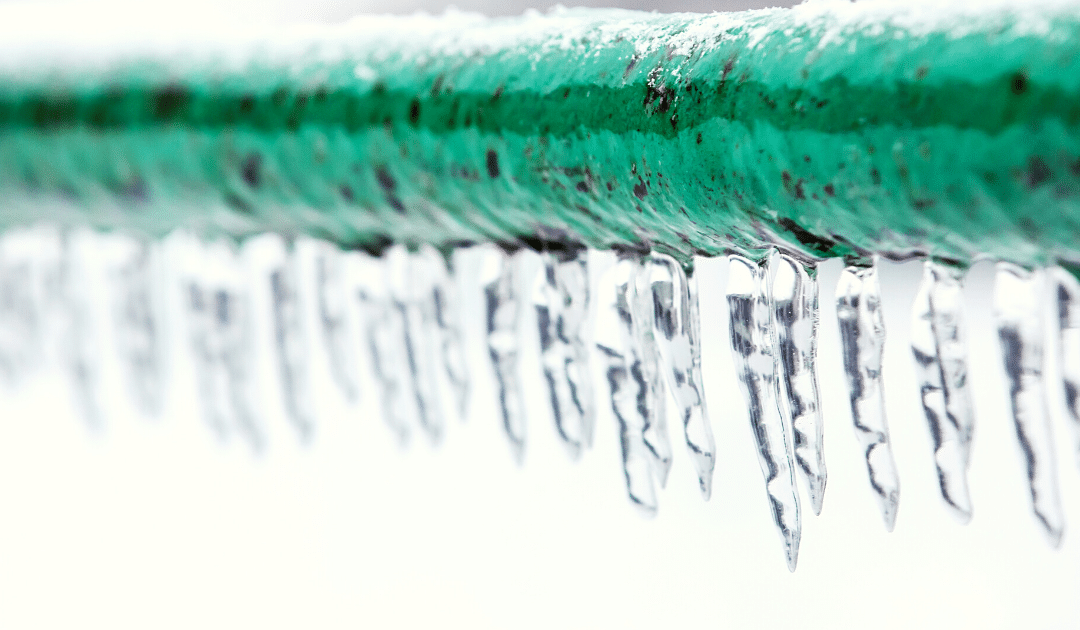Water expands when it freezes. This simple law of nature underlies all the damage, repair costs, and headaches associated with frozen or burst pipes.
The pressure of expanded, frozen water in your pipes can cause bulges, cracks, and burst joints, leading to leaks, flooding, and other expensive damage to your home.
By using the checklist below, you can take steps to prevent issues inside and outside your home and be ready to act if you suspect a frozen pipe.
Interior Checklist – Protect Pipes Inside Your Home
Use this list to take steps around your home to prevent frozen pipes.
-
- Keep interior doors open – Open bathroom and kitchen cabinets to let warmer air circulate around the pipes.
- Close the garage – If you have water lines in the garage, make sure the door’s closed so they stay warmer. Consider adding insulation to them if they’re accessible.
- Seal gaps – Seal up holes and cracks where pipes run through floors or walls to keep cold air from getting in and cooling the pipe. You can use caulk or spray foam insulation. If possible, seal from both the outside and inside.
- Add extra insulation – Attics, basements, and crawl spaces are typically cold, so adding insulation will keep temps up a bit. Fitting exposed pipes with foam rubber or fiberglass can be an easy and inexpensive option.
- Allow a drip – Letting cold water drip from the faucet (especially of exposed pipes) will help prevent pipes from freezing. A trickle is all you need.
- Keep the heat on – Especially during especially cold spells. Keep thermostat set to the same temp both day and night. A slightly higher heating bill for this short time is preferable to potential repair and damage costs.
Exterior Checklist – Protect Pipes Outside Your Home
After surveying your home’s interior, take this checklist outside.
-
- Hose patrol – You’ll need to remove, drain and store outdoor hoses. Shut off water to outdoor faucets, then turn on the faucet so any remaining water drains. Disconnect hose from the faucet, coil it into a 2-foot diameter loop, and store inside to protect from extreme temperatures.
- Drain the swimming pool – Drain the pool, pool water supply lines, and the sprinkler supply lines. Make sure to follow the manufacturer’s instructions and never use antifreeze in the lines.
- Consider heat tape – Heat tape is the umbrella term for a variety of cords and cables that you can use to insulate outdoor pipes to keep them from freezing. They can also be used to prevent ice dams in your gutters. There are self-regulating and thermostat-controlled models, and all are customized to the pipe(s) you’re protecting. If you go this route, make sure to do your research and follow the manufacturer’s instructions exactly.
If You Suspect a Frozen Pipe
Vigilance during cold weather is key, as you can often head off the worst damage if you catch a freeze in time. Here’s how to thaw a suspected frozen pipe:
-
- Locate the problem pipe – If you turn on a faucet and get no water or only a trickle, the pipe it’s connected to may well be frozen.
- Open the faucet – This will relieve the pressure on the pipe as you thaw it. If the faucet has handles for both warm and cold water, open both.
- Apply heat – Always start at the faucet and work down the pipe. Depending on the location of your pipe, use an electric hair dryer, portable space heater, towels soaked in hot water, or an electric heating pad (NEVER an open flame) to gently warm it back up. Have a family member watch for activity at the faucet. Apply heat until the full water pressure is restored.
- Check other pipes – Depending on how your plumbing system is set up, one frozen pipe may mean several (if they’re connected). Check all that you can and repeat the above process for any that are frozen.
Not only can frozen pipes cause expensive structural damage to your home but they can also cause health and safety issues for your family, pets, or livestock by cutting off your freshwater supply.
Use the above tips before and during cold weather events to keep your home and family safe. Check out more tips on preventing frozen pipe here.
This article is furnished by California Casualty. We specialize in providing auto and home insurance to educators, law enforcement officers, firefighters, and nurses. Get a quote at 1.866.704.8614 or www.calcas.com.
- Graduation – When to Remove Your Child from Your Auto Policy - May 18, 2023
- How to Prevent Catalytic Converter Theft - May 17, 2023
- How Much Does Home Insurance Cost? - May 17, 2023

